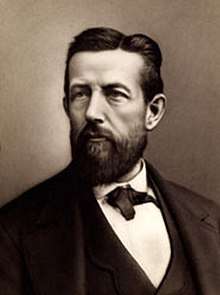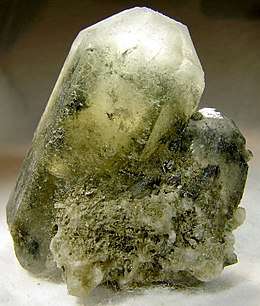Henry Garber Hanks
Henry Garber Hanks (May 12, 1826 – June 19, 1907) was an American mineralogist. He was the first state mineralogist of California.
Henry Garber Hanks | |
|---|---|
 Henry G. Hanks | |
| 1st State Mineralogist in California | |
| In office 1880 – 1886 | |
| Succeeded by | William Irelan Jr. |
| Personal details | |
| Born | May 12, 1826 Cleveland, Ohio |
| Died | June 19, 1907 (aged 81) Alameda County, California |
| Spouse(s) | Ellen Francis Barker |
| Children | 5 |
| Occupation | Gold miner, mineralogist, businessman |
| Known for | First State Mineralogist in California |
Early life
Henry Garber Hanks was born in Cleveland, Ohio, on May 12, 1826. His father Jarvis Frary Hanks was a local portrait painter; his mother was Charlotte Garber Hanks.[1]
Career
Around the age of 16, Hanks left Ohio for Boston, taking work as a seaman. In 1842, his ship sailed to Calcutta in British India, where he worked and traveled for about a year.[1] He then served as a seaman on another ship returning to New York. He then traveled around the continental United States while conducting scientific studies before returning to Cleveland to work as a house and sign painter.[1] Around the age of 25, Hanks left Ohio to join the Gold Rush in California.[1] Between 1852 and 1856, he worked as a miner and businessman around Sacramento. By 1860, he was mostly occupied with selling paint in San Francisco.[1]
In 1866, Hanks established Pacific Chemical Works, an assaying company. Hanks was also a founding member of the Microscopical Society of San Francisco (founded 1872) and its first president.[2]
He represented California as its mineral commissioner and the United States as its mineral superintendent at the 1878 Paris Exposition.[1] Following the State Geological Society's reorganization as part of the State Mining Bureau on 16 April 1880,[3] Henry was chosen by Governor Perkins on 15 May[4] to head the new organization as California's first state mineralogist.[5] Based in San Francisco,[4] he was responsible for inspecting and classifying geological specimens submitted to the bureau,[5] as well as providing studies, annual reports, and various special publications.[4] Taking charge of the old geological society's collection and other property, he established a public museum and library.[1] He served until 1886[4] at a salary of $3000 per year. He was responsible for the mineral exhibits of California and the United States at the 1884 New Orleans and 1893 Chicago World's Fairs.[1]
Personal life
In 1867, Hanks married Ellen Francis Barker. They had five children. One of his children Abbott joined Hanks's company as an assayer.[1]
On June 19, 1907, Hanks died in Alameda County, California.[1]
Legacy
Henry G. Hanks was the namesake of hanksite, a sulfate mineral identified by William Earl Hidden based on a specimen from Searles Lake in California in 1885.[6]
Works
- "Borax Deposits on the Pacific Coast", The Overland Monthly, Vol. XI, San Francisco: John H. Carmany & Co, July 1873, pp. 71–74.
- Catalogue: Private Collection of Henry G. Hanks, San Francisco, 1880.
- Annual Report of the State Mineralogist, from June 1, 1880, to December 1, 1880, San Francisco, 1880.
- Second Report of the State Mineralogist of California, from December 1, 1880, to October 1, 1882, Sacramento: California State Office, 1882.
- First Annual Catalogue of the State Museum of California..., Sacramento: California State Office, 1882.
- Third Annual Report of the State Mineralogist, Parts I & II, Sacramento: California State Office, 1883.
- Fourth Annual Report of the State Mineralogist for the Year Ending May 15, 1884, Sacramento: California State Office, 1884.
- Catalogue of the State Museum of California, Vol. 2, Sacramento: California State Office, 1884.
- Catalogue of Books, Maps, Lithographs, Photographs, Etc. in the Library of the State Mining Bureau at San Francisco, Sacramento: California State Office, 1884.
- Fifth Annual Report of the State Mineralogist, for the Year Ending May 15, 1885, Sacramento: California State Office, 1885.
- Sixth Annual Report of the State Mineralogist, Part I, Sacramento: California State Office, 1886.
- The Deep Lying Auriferous Gravels and Table Mountains of California, San Francisco: F.H. Abbott, 1901.
References
Bibliography
- "An Act to Provide for the Establishment and Maintenance of a Mining Bureau", The Statutes of California Passed at the Twenty-Third Session of the Legislature, 1880..., Sacramento: California State Office, 1880
- "California State Geologists and State Mineralogists", Official site, Sacramento: California Geological Survey, 2017
- California State Mining and Mineral Museum (PDF), Sacramento: California State Parks, 2010
- "Hanksite", Mindat, Keswick: Hudson Institute of Mineralogy, 2018
- Constitution of the San Francisco Microscopical Society... (PDF), San Francisco: Cubery & Co, 1874.
- Wilson, Wendell Eugene (2018), "Henry G. Hanks", Biographical Archive, Tucson: The Mineralogical Record
